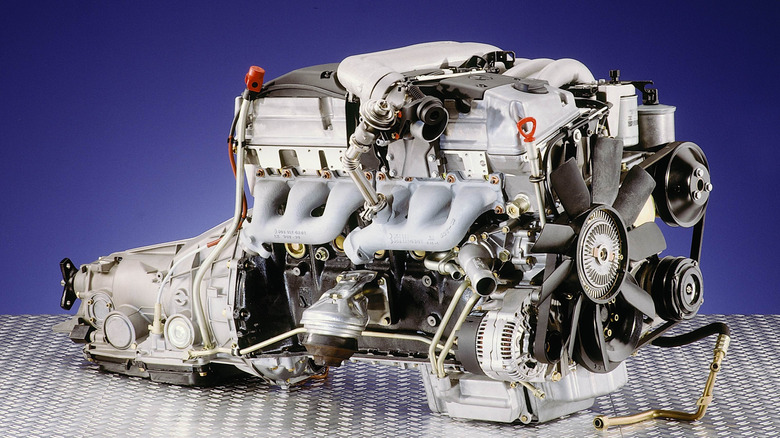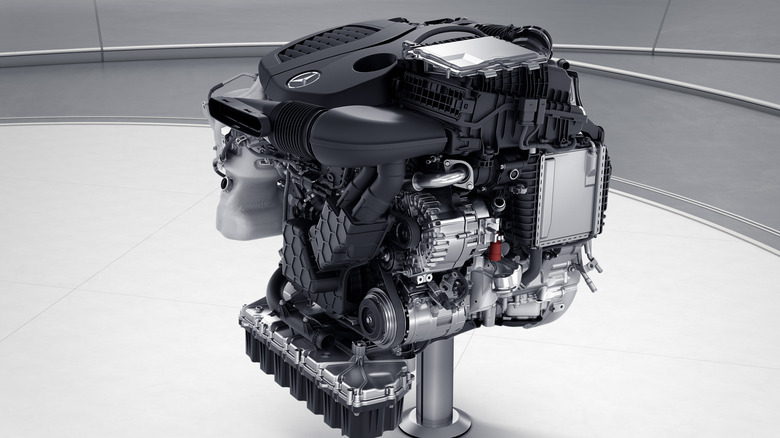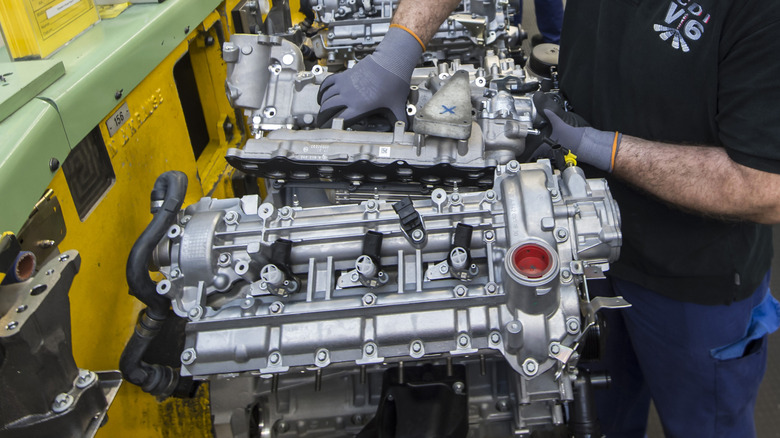6 Of The Most Powerful Mercedes Diesel Engines Ever Built
Mercedes-Benz has long made and sold diesel engines because of their excellent torque and fuel efficiency. How long? According to Mercedes, its 260 D became the world's first regular production diesel car way back in 1936, when it was unveiled at the International Motorcycle and Automobile Exhibition in Berlin.
While its gas-powered contemporary, the 200, slurped through an average of 3.43 gallons (13 liters) of fuel to drive 62.1 miles (100 km), the 260 D averaged only 2.38 gallons (9 liters) of diesel to cover that same distance. It's easy to see why Mercedes diesels soon became popular with taxi drivers and others tasked with a lot of driving.
Over the years, Mercedes continued to evolve its diesel designs, including the first five-cylinder diesel in 1974, riding the wave of popularity that diesel passenger vehicles sparked in the '80s and '90s. The automaker even went on to add a diesel hybrid to its lineup as part of its efforts to meet or surpass vehicle emissions restrictions. But what most people want to know is, how much horsepower do these engines put out? Let's look at some of the most powerful diesels from Mercedes.
OM 606
Back in 1993, Mercedes-Benz debuted the double overhead cam (DOHC) OM 606 diesel engine to replace its single overhead cam OM 603. The OM 606 design was based on the gasoline-powered six-cylinder M103 and M104 engines.
The German automaker manufactured both a naturally aspirated and a turbocharged version of the 3.0-liter, inline-six OM 606, with turbochargers becoming the sole choice for buyers in 1997. The naturally aspirated diesel produced 134 horsepower at 5,000 rpm. The turbocharged version of the OM 606 motor substantially boosted horsepower to 177 at 4,400 rpm. It also produced up to a respectable 330 lb-ft of torque at 3,000 rpm.
This engine worked its magic in a number of Mercedes vehicles including the W463 G 300, model years from 1996 to 2001; Mercedes E 300 sedans from 1993 to 1999; and the E 300 Turbodiesel Station Wagon from 1997 to 1999.
OM 612
The OM 612 was a five-cylinder diesel motor based on the four-cylinder OM 611. It came in two sizes: a 2.7-liter and a 3.0-liter AMG version. The 2.7L engine was rated to produce 161 horsepower at 4,200 rpm. The zippier 3.0L was boosted to muster up 228 hp at 3,800 rpm. Mercedes-Benz built these engines from 1999 to 2006 and used them in several different classes of vehicles ranging from CLK sedans to W163 ML-Class SUVs. But this engine even handled heavier vehicles such as Sprinter vans and G-Wagens.
The engine block was cast iron, but the block head was aluminum, which helped the engine shed some weight. Nonetheless, the OM 612 weighed in at 474 pounds.
Other models sporting the OM 612 included Mercedes C Class model years 2000 to 2007, and E Class cars from model years 1999 to 2003. Mercedes-Benz even loaded some Jeep Grand Cherokees with the OM 612 from 2002 to 2004.
OM 617
Mercedes based its OM 617 diesel on its OM 616 straight-four diesel engine, manufacturing it from 1974 to 1991. The OM 617 was a 3.0L five-cylinder turbo diesel that reached U.S. shores tucked inside of the 300 SD sedan in 1977. It became the first turbo diesel to power a production passenger car. Americans also enjoyed this special engine in the 300 TD (turbo diesel) station wagon in the late '70s and mid '80s. Sold around the globe, over 600,000 vehicles were built with this engine, including the Military Hagglund Bv206 Bandvagn.
How much horsepower did it produce? It was rated at 125 hp at 4,350 rpm fitted to the 300 CD turbo coupe. Additionally, the North American version had special equipment to limit diesel consumption at high altitudes in order to meet emissions standards and reduce smoke where the air was thinner.
That doesn't sound like a spectacular engine, but wait: in an inspired moment, the OM 617 was added, along with a five-speed manual transmission, to Mercedes' experimental supercar, the C-111. A few tweaks to the stock engine — a sturdier cam shaft, Garrett turbocharger, and an intercooler — and the OM 617 was able to push out a much more respectable 230 horsepower.
OM 654
Spring of 2016 saw the first all-aluminum, inline four-cylinder diesel from Mercedes. The OM 654 was the power plant for the E-Class E 220 d. The engine was a 2.0L turbo diesel that succeeded the OM 651 and weighed only 371 pounds.
The automaker designed it to be flexible enough to suit multiple vehicle configurations. The engine was built to produce different outputs for different uses and could be installed transversely or longitudinally for front-, rear- and all-wheel drive vehicles. This made the OM 654 appropriate for not only E-Class cars, but for Mercedes' A-, B-, and C-Class cars, as well as the bigger GL SUVs and — starting in 2023 — Sprinter vans.
The motor was rated at 192 horsepower at 3,800 rpm, based on it moving a 220d. The OM 654 that went into the CLS 300d four-door sedan had a much higher output rating, pumping out 241 horsepower at 4,200 rpm.
OM 642
Of course, you'd expect bigger performance from a bigger engine, and the V6 OM 642 doesn't disappoint, with 261 horsepower for European models and 211 horsepower for U.S. vehicles. This 24-valve, DOHC diesel was introduced in 2005 and built with an aluminum block and heads. It had a variable geometry turbocharger that was noted for avoiding the typical turbo lag, and for boosting power across a range of engine speeds. The 459-pound engine was also designed to dampen its own V6 vibrations for smoother driving.
Powerful and efficient, the OM 642 became the darling of its automaker, appearing in Mercedes E-Class sedans and wagons and ML and GL SUVs. But the OM 642 also suited heavier vehicles, and Mercedes bunged the engine into Sprinter vans with Mercedes-Benz, Dodge, and Freightliner nameplates. Jeep Grand Cherokees in Europe and North America benefited from the many upsides of this engine, too.
To meet increasingly stringent emissions standards, the light-duty vehicles use a NOx storage catalyst to grab nitrous oxides and a particulate filter to catch soot. Mercedes' BlueTec AdBlue urea injection helps reduce emissions in the larger vehicles.
OM 656
And here comes the heavyweight –- the OM 656. Production of this diesel engine started in 2016, to take the place of the OM 642. The OM 656 first went into the W222 S-Class luxury four-door sedan, but later graced wagons and G-Wagens.
The 2.9L OM 656 is a straight-six, with a BorgWarner eBooster electrically driven compressor to supercharge it. It also has two-stage turbocharging. Through careful engineering, it simultaneously bumps up horsepower and cuts fuel use. It saves some weight using an all-aluminum engine block with steel pistons.
The OM 656 is offered in two output classes for S-Class vehicles and is available with 4MATIC all-wheel drive. The S 350 d delivers 286 horsepower. The S 400 d delivers 340 horsepower. But why stop there? Mercedes doesn't. The automaker has plugged a modified OM 656 3.0-liter, inline-six engine into the GLE 450 d 4Matic, garnering an impressive 367 horsepower at 4,000 rpm. Mercedes calls it "the world's most powerful passenger car diesel."






